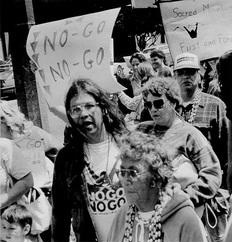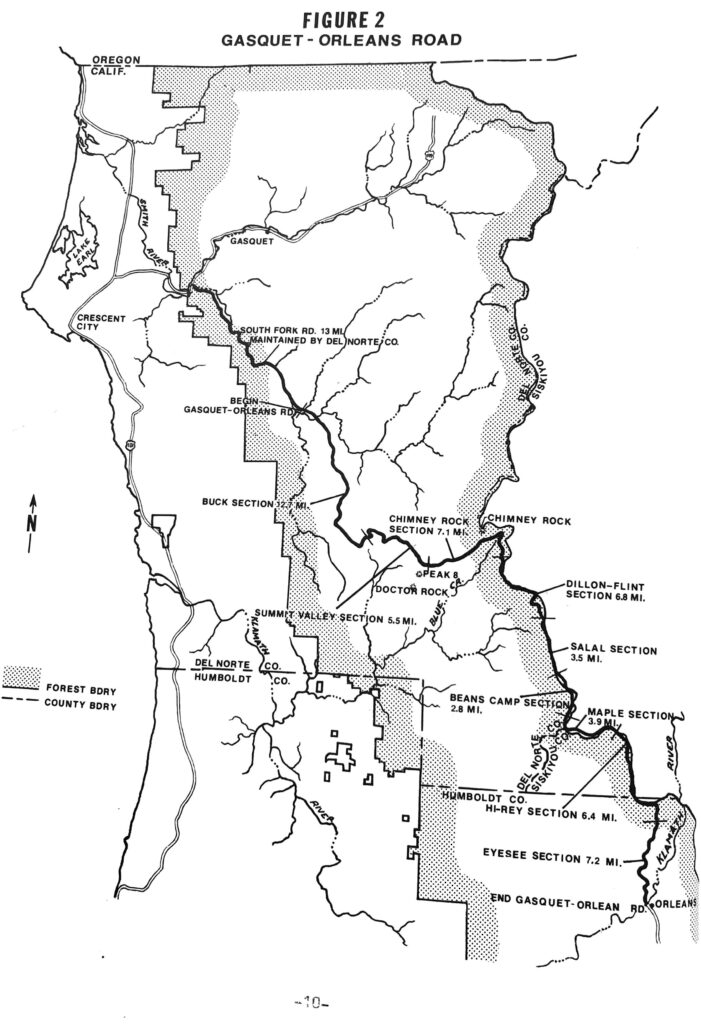The Gasquet to Orleans Road Controversy
Using case study methodology to examine and debate Indigenous land use in Northern California

Activist Julian Lange at a NO-GO Road Protest
Overview and Context
In this lesson, high school students will use a case study methodology to analyze the beginning and eventual halt to construction of the proposed road from Gasquet to Orleans in California. They will look at the question of Native Sovereignty in relation and opposition to Federal land use rights.
This original lesson took place in Humboldt County, Northern California, but can be adapted for a different local historical event because it allows students to closely examine historical documents and craft perspective-based papers that analyze multiple sides of an issue. For your own class, you could look at other examples of the exercise of Native Tribal rights on land or religious practices: See document for potential cases.
California Standards Addressed
CA History/Social Science Standards: 12.7 Students analyze and compare the powers and procedures of the national, state, tribal, and local governments.
C3 Framework
- D2.Civ.1.9-12. Distinguish the powers and responsibilities of local, state, tribal, national, and international civic and political institutions.
- D2.Civ.4.9-12. Explain how the U.S. Constitution establishes a system of government that has powers, responsibilities, and limits that have changed over time and that are still contested.
- D2.Civ.5.9-12. Evaluate citizens’ and institutions’ effectiveness in addressing social and political problems at the local, state, tribal, national, and/or international level.
- D2.Civ.9.9-12. Use appropriate deliberative processes in multiple settings.
Assessment
A Student Activity Matrix is provided in the related materials; this will serve as a portion of the assessment. A student reflection on the court case and arguments used will also be completed.
Resources and Materials
- G-O Road Presentation and Resources
- Perspectives
- G-O Road Case Study Graphic Organizer
- Background and summary of area pre-road
- Other examples of items that could be made in case study of Native Nations…
- Summary of Court Cases
- Timeline of events leading to G-O Proposal
- G-O Road Map
- G-O Road Map Project Area
- Court Cases Transcript
Step-by-Step Instructional Plan
1. Introduction to Concepts and Focus Question
Have students choose a question for their table to discuss and try to provide a historical example.
How can people with different social values live together?
- Should all students at a high school have the same values?
- Should all people be allowed to share their values at school?
Should a majority have the power to coerce minorities to act against their conscience?
- If a majority of students believe that uniforms should be imposed should everyone be forced to comply?
- If a majority of students believe that a morning prayer should be practiced every day, should that become the policy?
2. Introduction of Focus Question
Should the federal government deny people access to their religion?
- How does this question relate to the questions above?
- Mentimeter poll and Discussion: why do we see the numbers so heavily skewed one direction?
3. Introduction to Target Question
Present target question:
Should the U.S. Forest Service have the power to build a road and to permit timber harvesting on the Six Rivers National Forest in the Siskiyou Mountains or should a religious community of some 4,500 persons who at the core of their beliefs, use the area for meditation and preparation for rituals?
Present Quote: “Over the years, the GO Road became much more than a conflict over natural resources. In large measure, it was a clash of two cultures–one driven by economic imperatives that demanded the landscape be altered and put to use to satisfy human material needs; the other asking that the landscape be left intact for the spiritual renewal and well-being of its inhabitants. Widely differing value systems held by Indians, environmentalists, and Forest Service personnel, more than anything else, fueled the fires of the GO Road dispute.” -Robert Dale
4. Point of Drama: Reading the Court Transcript
Court transcript (copies made or presented to class) is linked in the “Materials” section of “The Gasquet to Orleans Road Controversy Lesson Overview and Materials. This will need 3 readers and it’s helpful if the teachers serves as the reader of Ms. Breanan due to length and language.
After reading, students will explore the following questions:
- What stands out to you?
- What did she say about the land? People? Needs? Issues
- Who does she represent?
- Why was she in court?
5. Background of Area and Summary of Issue
*All maps and other materials are linked in the “Materials” section.
It’s helpful to have students complete a map on the area for familiarity with region, rivers, and mountains (not provided). Then students will read the Background and Summary of area pre-road, and review Timeline Summary of events from 19602-1980s. Students should refocus back to the major question: Who should be able to use the land?
6. Presentation of Differing Viewpoints
Create expert groups by breaking students into groups of 3 or 4, depending on class size. Students should use the graphic organizer to complete the graphic organizer. The groups are:
Next, students will read their summary positions on the issue of the road and analyze the primary source.
This part of the lesson will conclude with a class discussion, where students share out major ideas and thoughts of each position and fill in their organizer as other groups present. Use a Mentimeter poll to see where students stand on the target question and rank the groups in the order that you think they should have access to the lands in question.
7. Presentation of Court Rulings
First, review the 1983 ruling and the 1986 Appellate Decision. That page also includes the SC decision and you might want to alter if giving to students.
Next, listen to the 1987 Supreme Court Case G-O Road oral arguments (total time is about 56 minutes and transcript is provided). Conduct a second Mentimeter poll: Who do you think won based on the oral arguments?
Next is the 1988 Supreme Court Decision. (Copies include majority and minority decisions.) This section is complicated and will require a teacher-led breakdown. You can also go here for basic ideas of the decision (also includes audio component).
Finally, look at the International Law perspective and see the Summary of Court Cases to learn how the case was taken to the Organization of the American States.
8. Outcome of Situation
A series of laws were passed that barred the construction of the road; see the document titled “Legislation” for a summary of laws that were passed that helped to protect the land in question after the Supreme Court decision.
9. Assessment
Student Activity Matrix (page 9) will serve as a portion of the assessment. A student reflection on the court cases and arguments used will also be completed, and students will answer the following questions:
- Do they feel justice was served?
- Can they think of other potential solutions to the case?
- Are there any circumstances under which the case should be re-evaluated?
- If this issue were to arise again, how might they proceed? What actions might they take? What would be most meaningful?
Extensions and/or Enrichment
- Look at other examples of the exercise of Native Tribal rights on land or religious practices: See document for potential cases
- also located in the Lesson Plan Document/Handout folder
- Have students create a presentation on the issues in the case and discuss the outcome.


